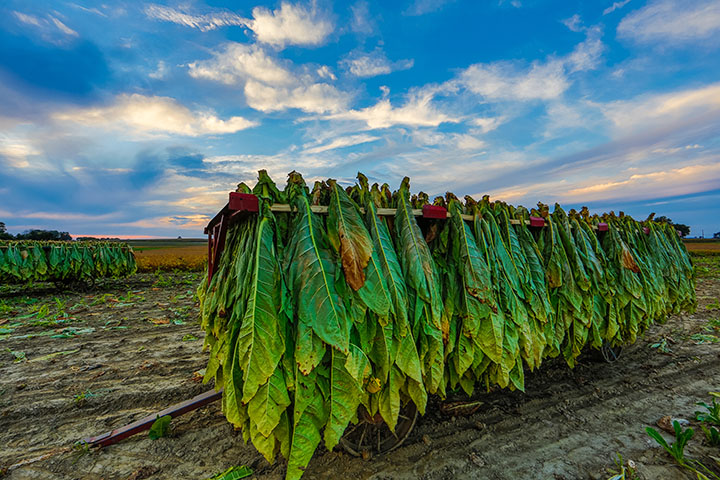
As time went on, tobacco and tobacco usage became very common in the Americas. There is a drawing of smoking by the ancient Mayas from about 1400 years ago. In it, a Mayan is shown smoking a roll of tobacco leaves tied with a string.
COLUMBUS
Tobacco was first discovered by Europeans via Christopher Columbus. Columbus received dried tobacco leaves as gifts when he landed in what is now the Caribbean. Two of his crew are credited with first observing smoking when they were exploring what is now Cuba. The natives taught them how to smoke and one of the crew, Rodrigo de Jerez took the habit home to Europe. In fact his neighbors were so frightened by seeing smoke coming out of his nose and mouth that they notified the local Inquisition. Jerez was jailed for 7 years (and you thought smokers had it tough nowadays)! By the time Jerez was finally released, smoking had become all the rage in Spain.
BLUNTED ENDS
Smoking at that time was done via loosely rolled, open ended cigar type products with multiple wrappers or binders held together by licking the ends of the leaves. As cigar smoking progressed many improvements came to Cigars. For example, one ‘new’ style of cigar rolling formed a rounded smooth tip. This “Blunt” end caused this new style to be called a Blunt. Nowadays most cigars, even Coronas and Robustos have this same rounded end but the original term Blunt still applies.
INHALATION BEGINS
The birth of the modern rolled cigarette happened in 1614 in Seville. King Philip III required all tobacco grown in the Spanish New World to be shipped to a central location in Seville, to control pricing and prevent oversupply. Because of this, Seville became the world center for the production of cigars. Street beggars would pick up the remainders of used cigars, take them apart and re-roll them in newspaper. Because of the scarcity of tobacco and their desire to enjoy every drop, they began holding the smoke in their lungs (inhaling). This took hold and made its way through the working class until the practice became common. Thus the modern hand-rolled cigarette was born.
THE DAWN OF CIGARETTE PAPER
Of course burning newspaper had its own problems, especially with the then lead based inks. Spanish merchants began offering plain unprinted paper for this purpose. One factory in Alcoy that was making specialized packing papers offered the first paper designed specifically for cigarette rolling. This paper was later improved and an additional factory in Alcoy opened to compete.
Over time additional cigarette paper factories opened near Barcelona, then France, the UK and eventually there were many factories across Europe. In Alcoy Spain there still is one rolling paper factory left, which can actually trace its roots back to the first rollingpaper factory. This Alcoy factory produces many of our popular papers to date. Brands such as RAW, Elements, Juicy Jay’s & DLX are made using processes that date back to the origin of this factory. Some of the craftsmen at this factory have been making papers for generations!
SIZES
In Spain, the size that was developed based on consumer preference was approximately 78mm long by 44mm high. At first this was the size that dominated the entire European market. However, King James 1 and his later successors enacted heavy tobacco taxes. This led the British market to move to a smaller size which held about 25% less tobacco. This new small size was about 70mm long by 38mm high. As the British Empire grew, so did the proliferation of this smaller British sized rolling paper. In fact, to this date in most of the common wealth countries the #1 selling size is this small 70mm paper. This paper became known as “Standard Size” or “Single Wide”. The original Spanish 78mm paper became known as “Spanish Size”, except the British referred to it as One and quarter, in reference to how it holds about 25% more tobacco than a British Standard Sized paper.
THE KING IS BORN
Flash forward about 100 years and the industrial revolution allowed the mass production of machine made cigarettes. At first, most cigarettes were either 70mm or 78mm long without a filter. However in the 1950’s filtered cigarettes began to take over. Consumers were concerned that by purchasing a filtered cigarette they were getting less tobacco as the filter took up some of the cigarette’s space that used to be filled with tobacco. Thus large tobacco companies responded to this by increasing the length of cigarettes to accommodate the filter. Cigarette size increased from 70mm or 78mm to a new 84mm size. This new size became known as “King Size”, named after the King of England who was seen publicly smoking this new cigarette. Over the next several decades the shorter cigarettes saw their market share shrink dramatically until they were all but replaced by the new 84mm “King Size”. However rolling paper factories missed the opportunity to change their sizes to suit this new consumer preference and continued producing the legacy sizes of generations past. It wasn’t until 2009 when HBI finally produced the world’s first 84mm cigarette rolling papers with their launch of DLX brand 84’s as they are called. While it may appear that rolling paper companies are dramatically behind the times, this is common among rolling paper factories as most companies prefer not to change with the times. However this sort of dinosaur attitude has recently been changing as new and improved forms of cigarette papers have been launched in recent years. Among them are natural unbleached and unrefined papers (i.e. RAW), ultra thin rice papers (i.e. Elements), and extra slow burning papers (i.e. DLX). The next oldest significant rolling paper innovation was the invention of interleaved rolling papers which was launched 110 years ago at the 1900 wold’s fair, and led tothe formation of the Zig Zag brand. Zig Zag means how the papers are interleaved in a zig-zag format.
CONFUSED?
In Commonwealth countries the #1 selling size is still the 70mm standard size papers.However, in the rest of the world including the USA, Spanish Size (1¼) is by far the better seller. Overall there has been a market trend towards this original 1¼ size and sales data has shown that it is increasing in popularity, especially in the UK and Canada. Now that there is finally an 84mm rolling paper available, sales of that size are increasing steadily and will likely eventually become one of the most popular sizes, mirroring the extreme popularity of 84mm King Size Cigarettes.
Now we’d like to address so-called King Size rolling papers which are actually miss-named. This date back to 1984 when Rizla launched their 100mm rolling papers catered towards women that preferred the 100mm cigarette size. People first referred to this as “Queen Size”. Another firm tried to outdo Rizla and launched a 110mm paper, and named it “King Size’. However this is a misnomer.
King Size cigarettes are all 84mm long. A 110mm paper is actually a longer “Queen Size” and is much longer then the preferred 84mm standard King Size. The aforementioned “King Size” rolling papers were typically 110mm long and 52mm high. However the newer format of this “King Size” is 110mm long and 44mm high (sometimes called King Size, sometimes called King Size Slim). This has become one of the most popular sizes in Europe and is growing while the older King Size is decreasing. The difference is the 8mm in paper height. The 44mm height is the original “Spanish Sized” or 1¼ sized height, and seems to be the preferred height by most smokers for all rolling papers (regardless of length).
BOOKLET
The origins of the cigarette rolling paper booklet can be traced back to a Dominican priest, Father Jaime Villanueva Estingo (Jativa, Spain, 1765). Before Father Villanueva's invention, tobacco smokers laboriously and wastefully cut sections of large sheets of paper to roll their cigarettes. He devised a more convenient method of peeling small sheets from pocket-size booklet dispensers and brought his idea to Alcoy, where the first rolling paper booklet s ever were produced. People still pay homage to Father Villanueva in Alcoy to this very day.
INFO ON PAPER COMPANIES
There are 3 huge multinational rolling paper companies:
One of the largest is Republic/Bollore in France. They make Job®, Top®, Zig Zag®, OCB®, Gambler® and Abadie®.
Their key competitor is Imperial Tobacco UK. This large multinational tobacco company owns Rizla®, Joker®, and EZ-Wider®.
Another very large outfit is Miquel Y Costas. They are the makers of Smoking brand, Bugler papers, Pure Hemp brand and Bambu.
After these 3 big guys come a series of independent brands (RAW®, Elements , DLX®, Skunk®, Hempire ®, Chills®, Zen®, Juicy Jays®, etc.).
Special Note about China - While China did invent paper; they did not invent cigarette paper with good cause. The Chinese Emperor Chongzhen banned tobacco and ordered that anyone who smoked it should be beheaded. Tobacco was completely forbidden in China for hundreds of years and thus no cigarette paper was ever developed there. It is only quite recently that China has begun producing any cigarette rolling paper. Most of the cheaper rolling papers now coming out of china are actually shoe paper (the crinkly paper that you find stuffed into the toe of a new pair of shoes) being marketed as rolling paper. While the two look similar, shoe paper burns fast and tears easily. The Europeans have a long head start over the Chinese when it comes to cigarette rolling papers, and have mastered their craft over many generations and hundreds of years.
* There are also the large companies Gizeh of Germany and Op Paprina of the Czech Republic however these two mostly sell in their home markets.
* One interesting note is that the first flavored tobacco was smoked by the ancient Mayans who perfumed their tobacco with reeds.
That may predate Juicy Cigars for originality, but we’re certain that Juicy Cigars taste much better.
* There is a story that cigarettes were invented in 1750 by Egyptian soldiers who had broken their only pipe. The story goes that they used leftover paper that had been used to wrap munitions in order to smoke. However there is no actual proof of this story whereas the Spanish street beggar story has much documentation.
